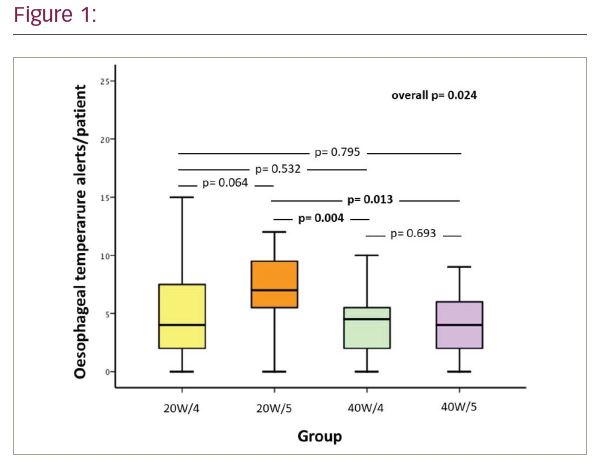Background: Low radiofrequency (RF) powers are commonly used on the posterior wall of the left atrium (LA) for atrial fibrillation (AF) ablation to prevent oesophageal damage. Compared with higher powers, they require longer ablation durations to achieve a target lesion size index (LSI). Oesophageal heating during ablation is the result of a time-dependent process of conductive heating produced by nearby RF delivery. This randomized study was conducted to compare risk of oesophageal heating and acute procedure success of different LSI-guided ablation protocols combining higher or lower RF power and different target LSI values.
Methods: Eighty consecutive patients were prospectively enrolled and randomised to one of 4 combinations of RF power and target LSI for ablation on the LA posterior wall (20W/LSI 4, 20W/LSI 5, 40W/LSI 4 and 40W/LSI 5). The primary endpoint of the study was the occurrence and number of oesophageal temperature alerts (OTAs) per patient during ablation. Acute indicators of procedure success were considered as secondary end-points. Long term follow-up data were also collected for all patients.
Results: Oesophageal temperature alerts (OTAs) occurred in a similar proportion of patients in all groups (Figure 1). Significantly shorter RF durations were required to achieve the target LSI in the 40W groups. Less than 50% of the RF lesions reached the target LSI of 5 when using 20W despite a longer RF duration. A lower rate of first-pass Pulmonary Vein Isolation and a higher rate of acute Pulmonary Vein Reconnection were recorded in the group 20W/LSI 5. A lower AF recurrence rate was observed in the 40W groups compared to the 20W groups at 29 months follow-up (p=0.015; Figure 2). An LSI of at least 5 on the LA posterior wall was associated with better long-term outcomes (p=0.004; Figure 3).
Conclusions: When guided by LSI, posterior wall ablation with 40W is associated with a similar rate of oesophageal temperature alerts and a lower AF recurrence rate at follow-up if compared to 20W. These data will provide a basis to plan future randomised trials










